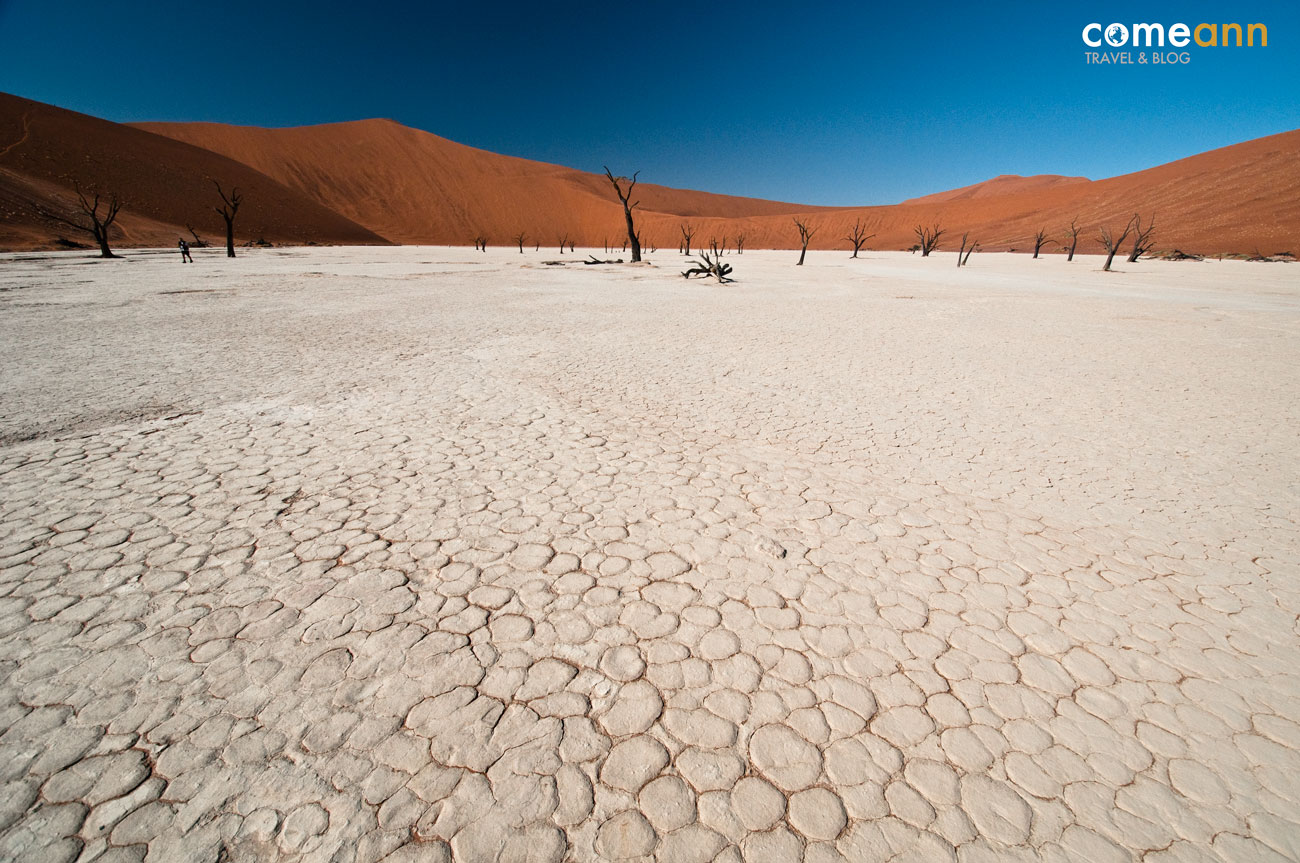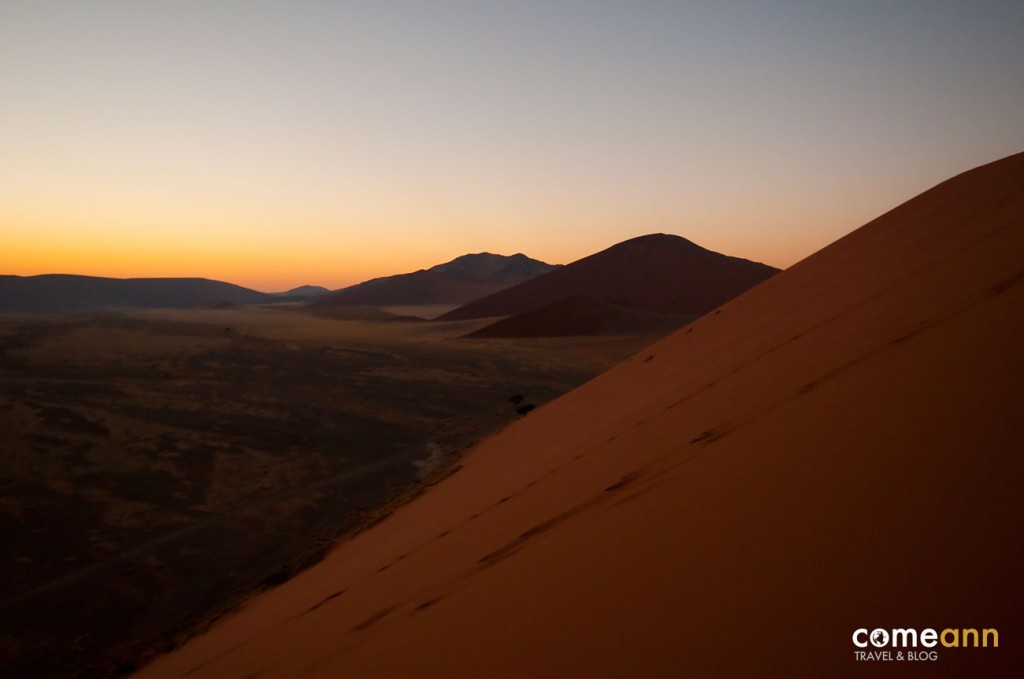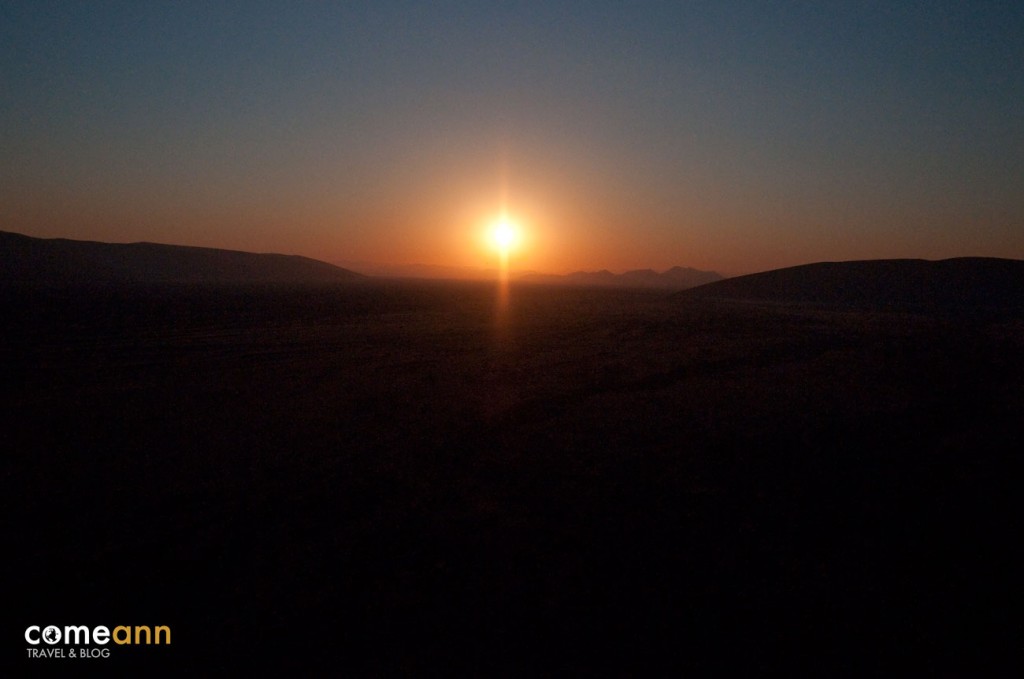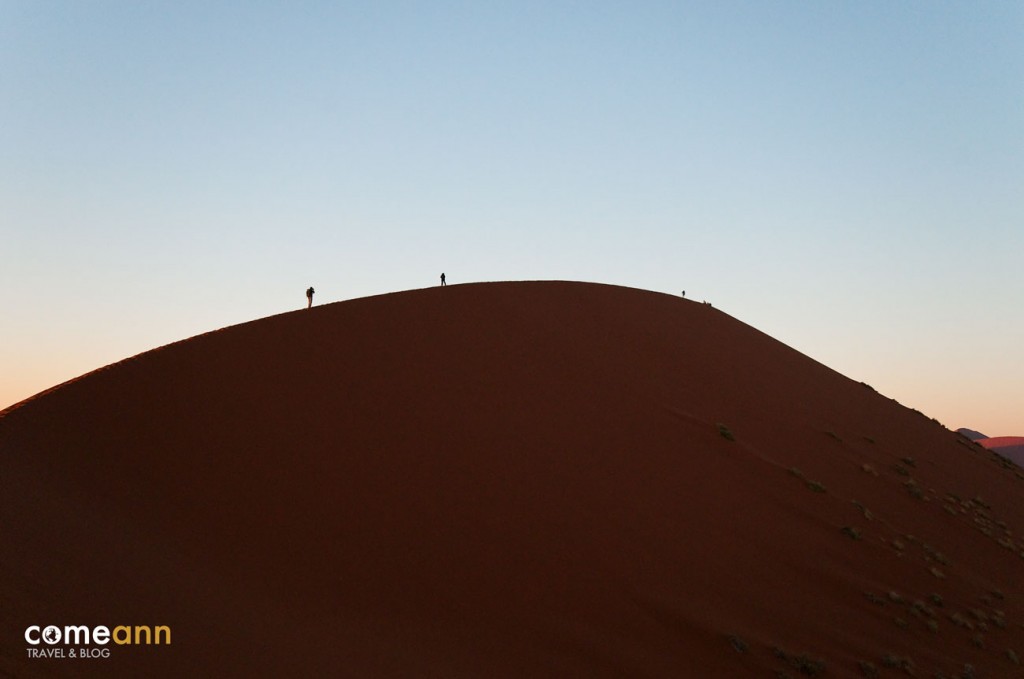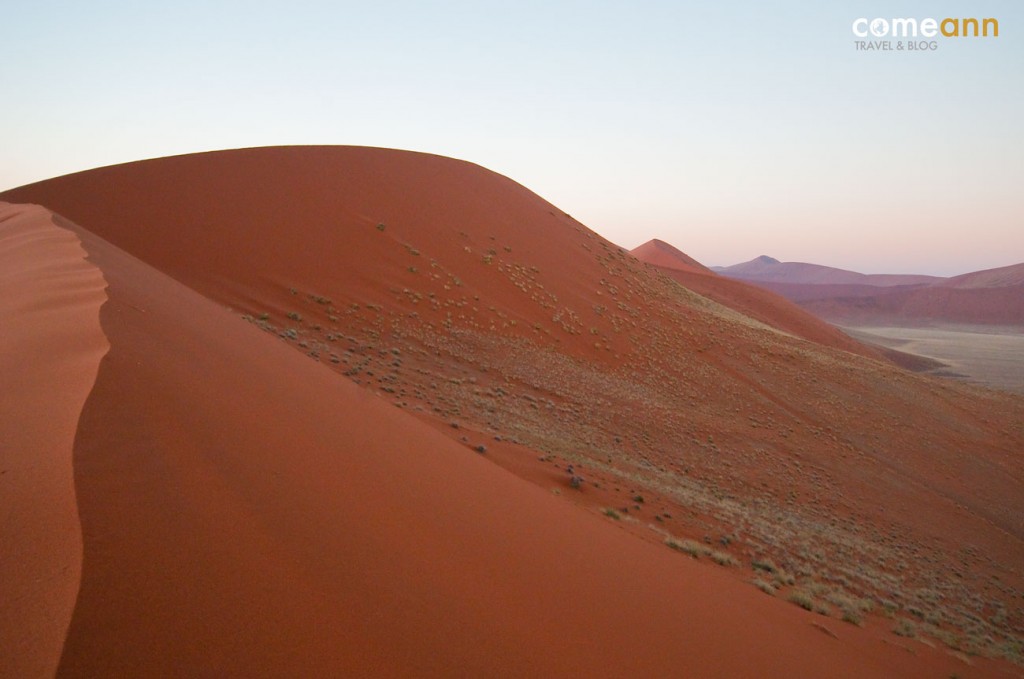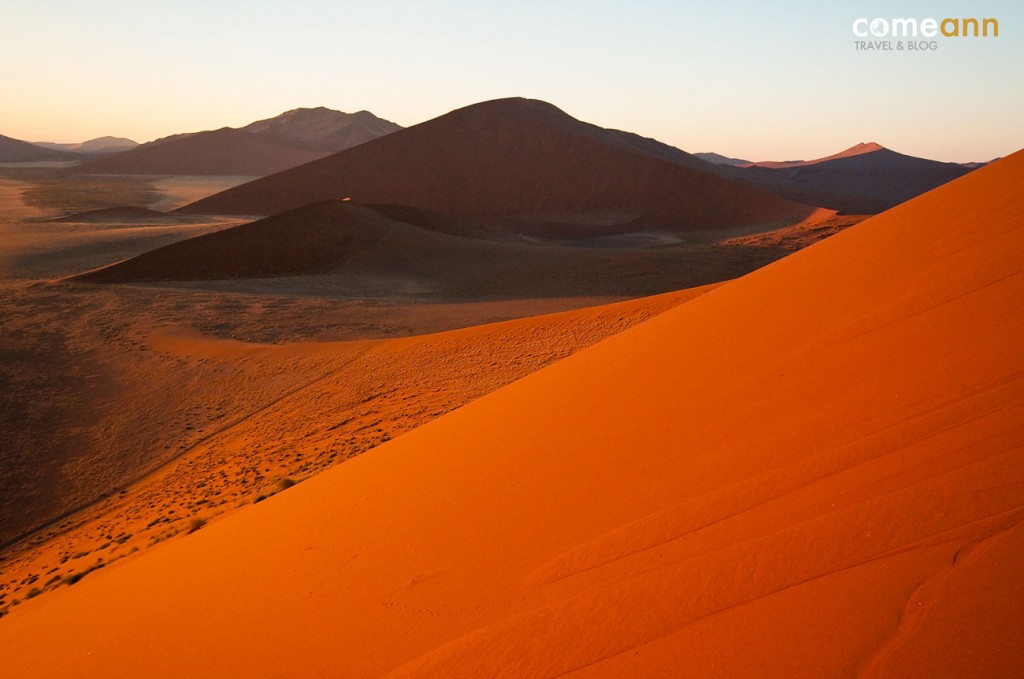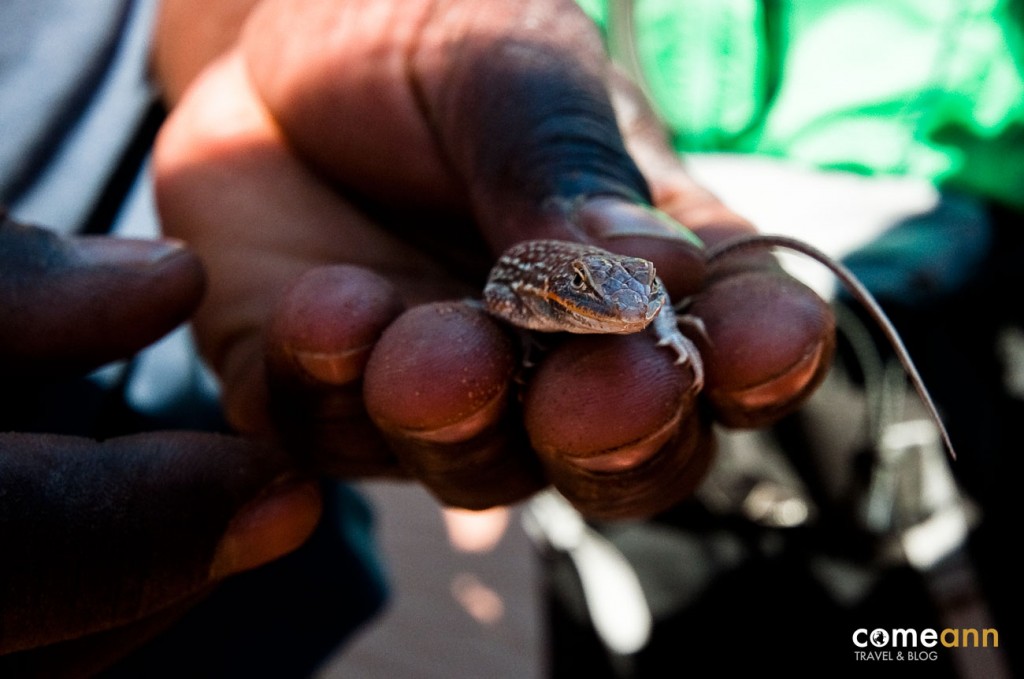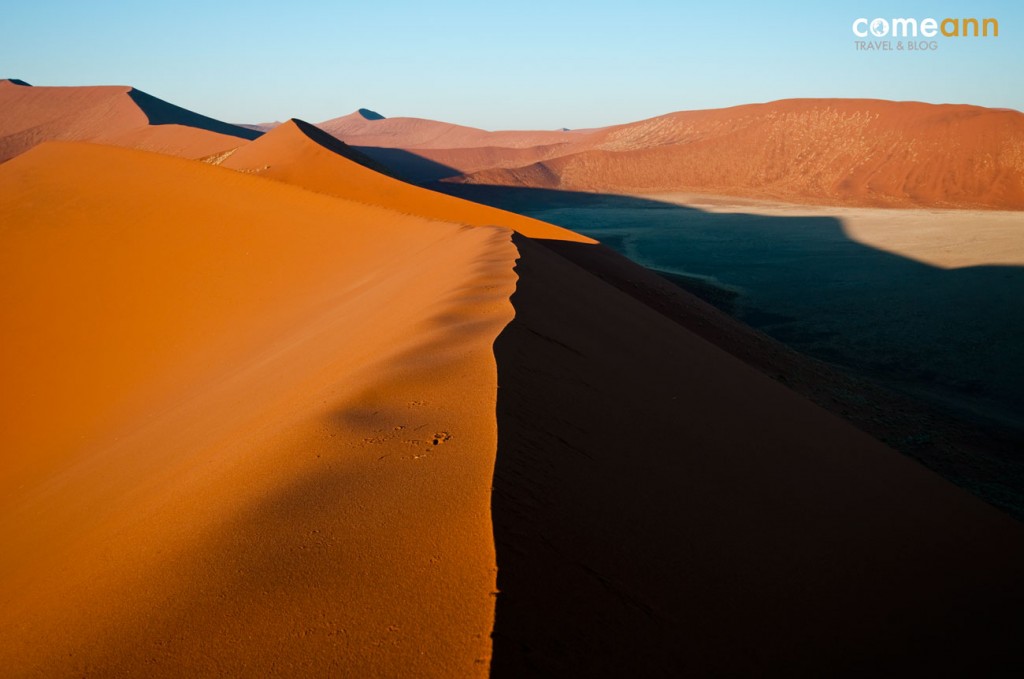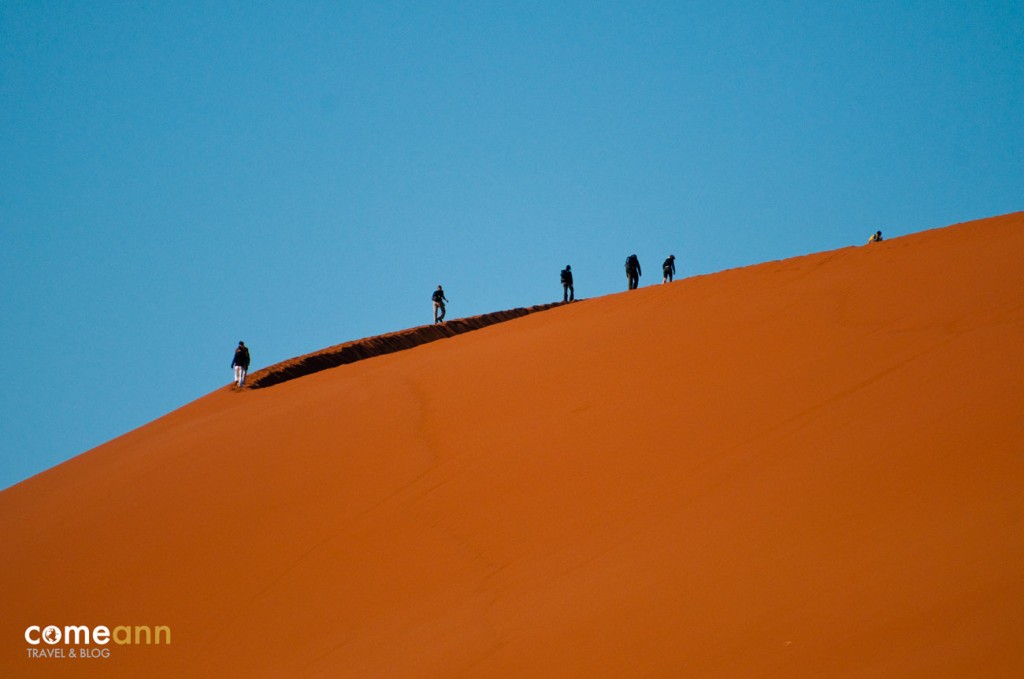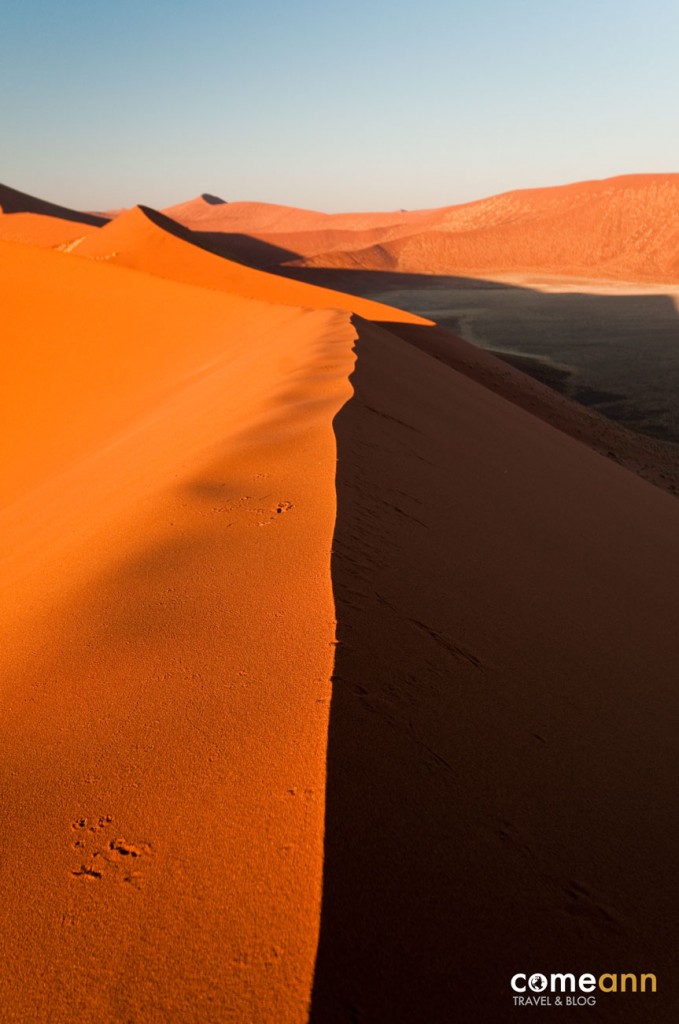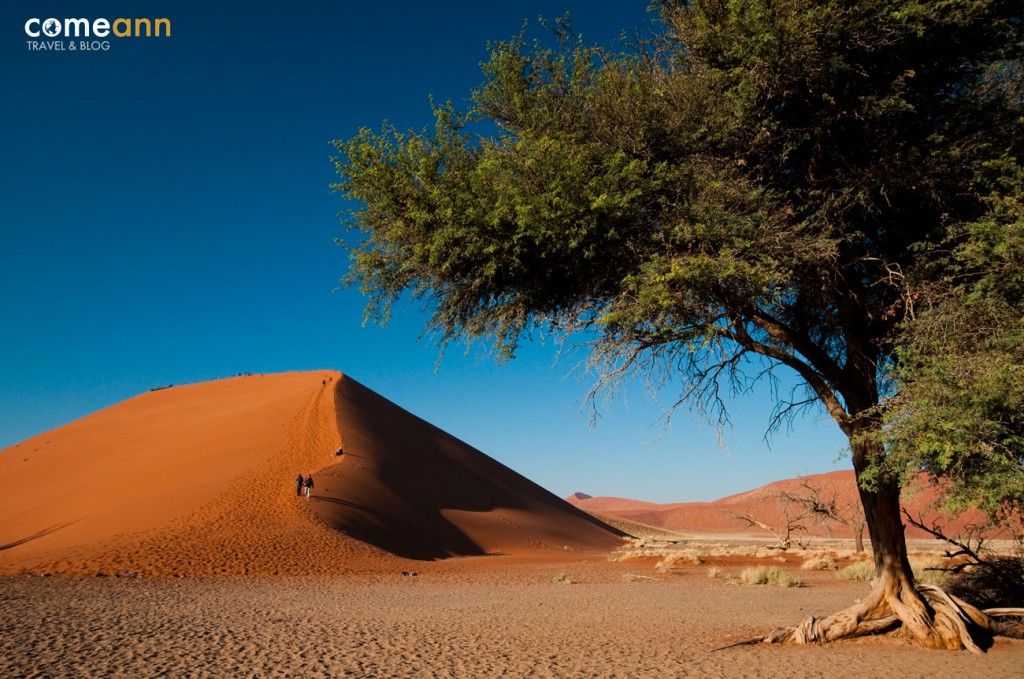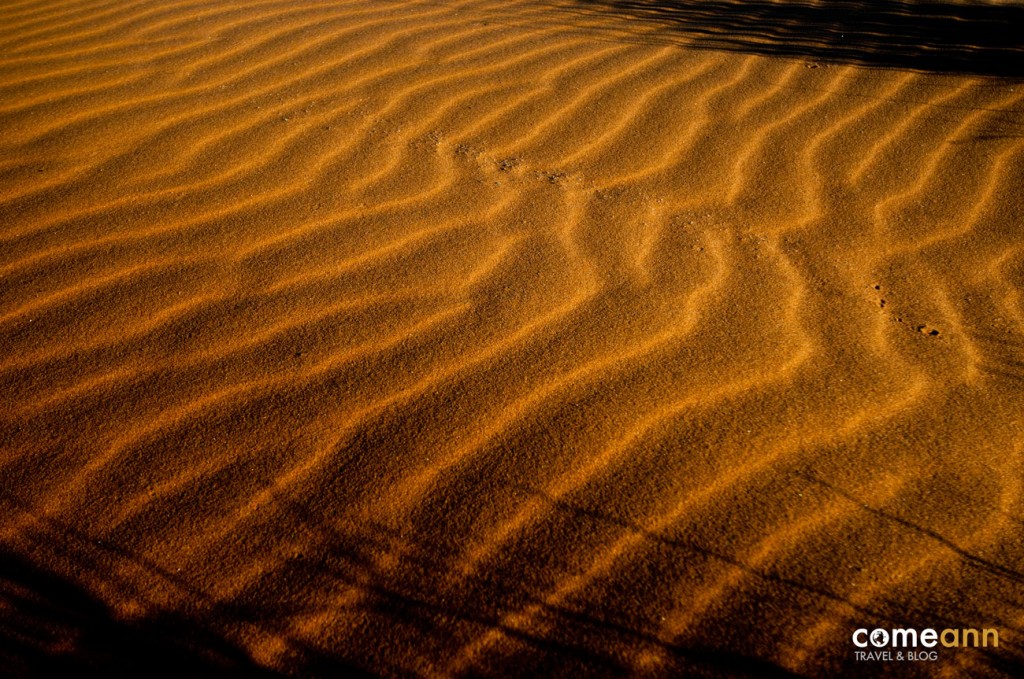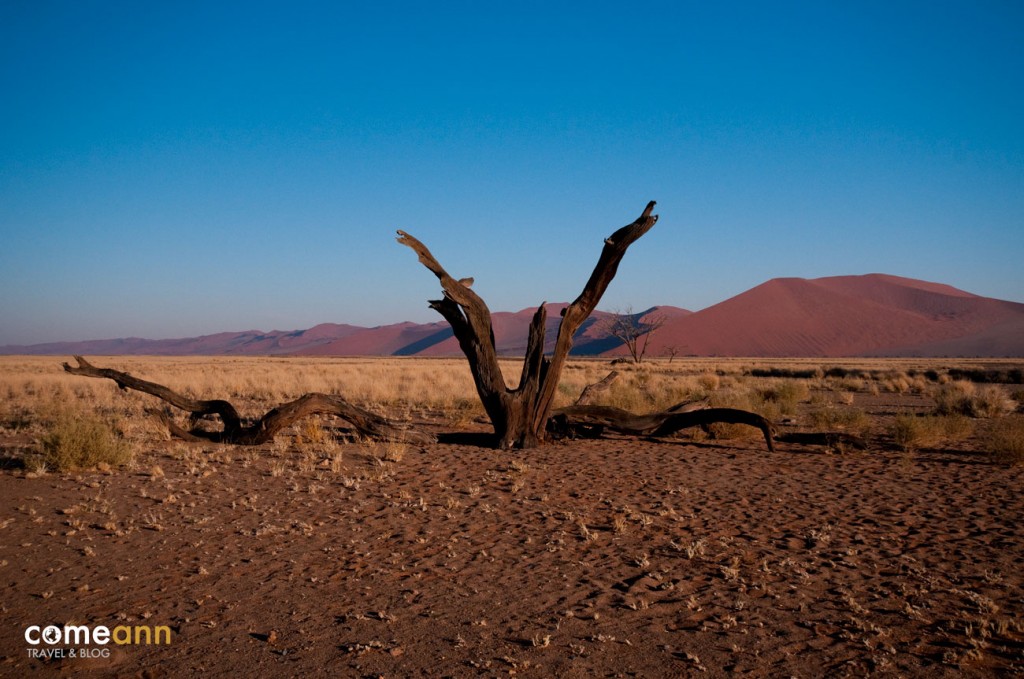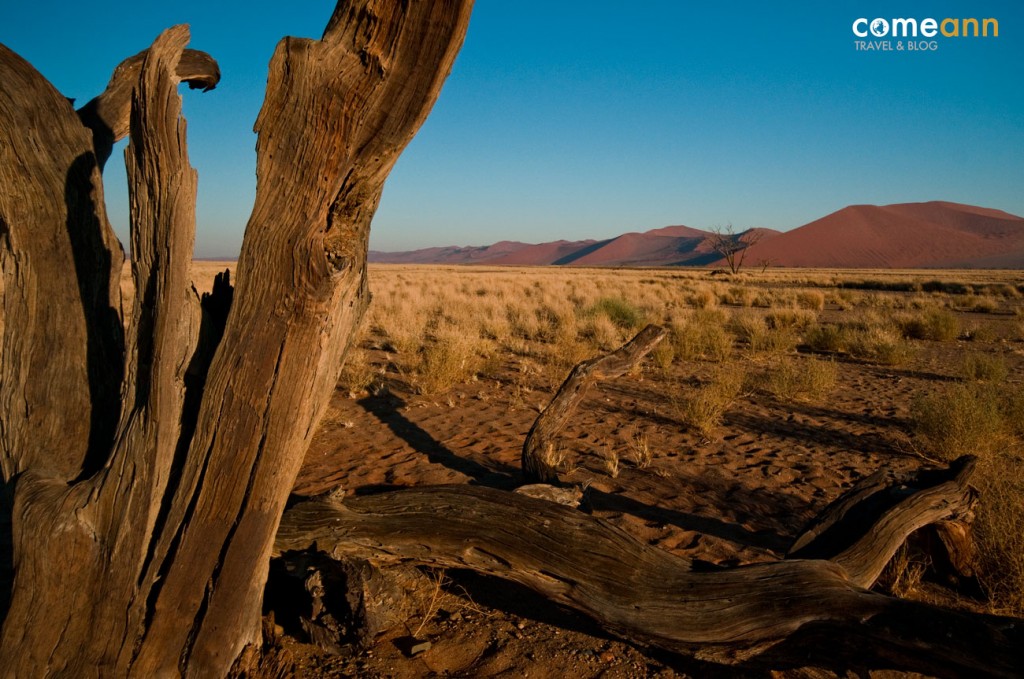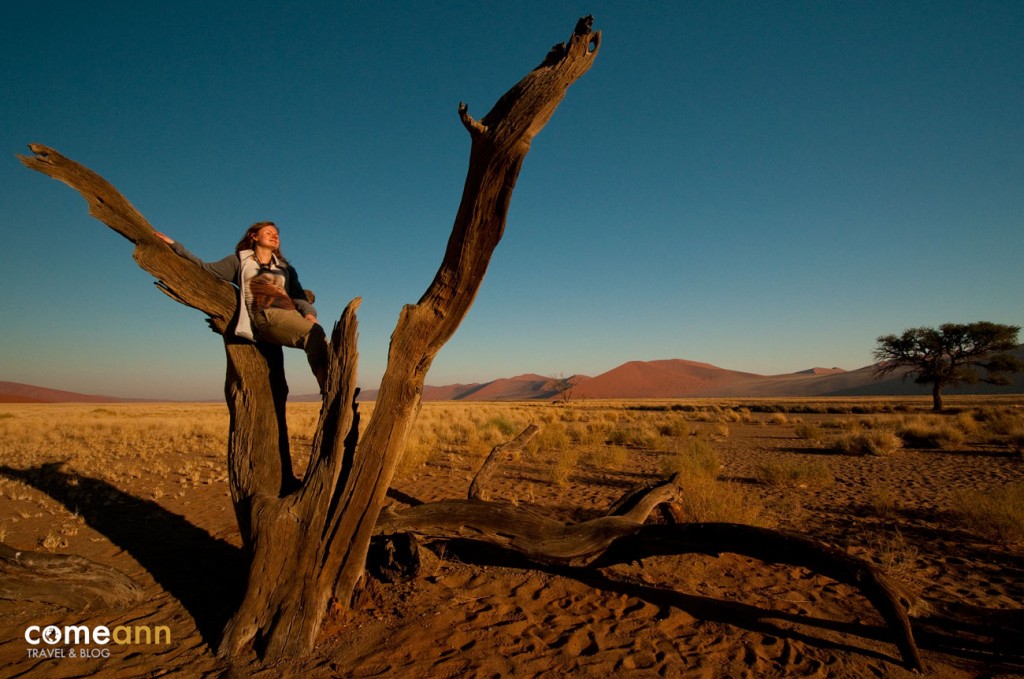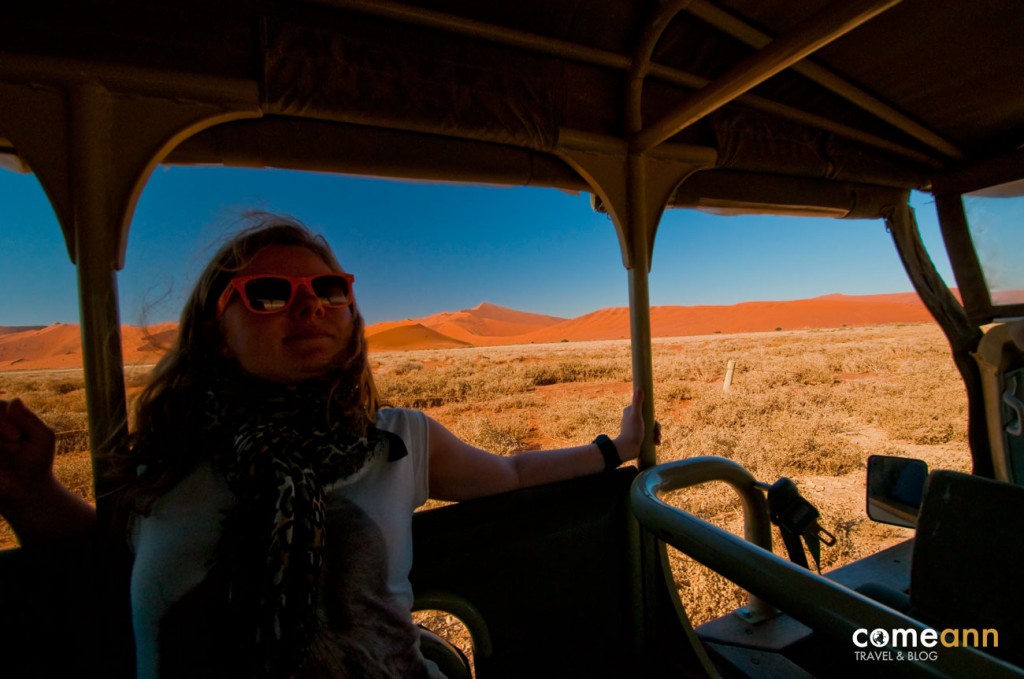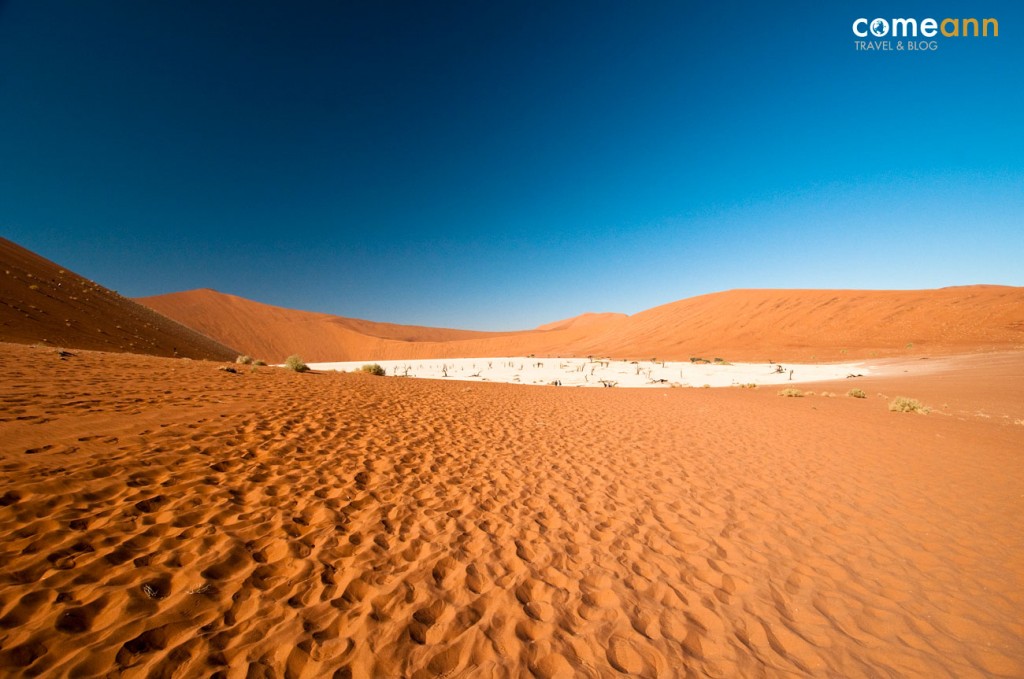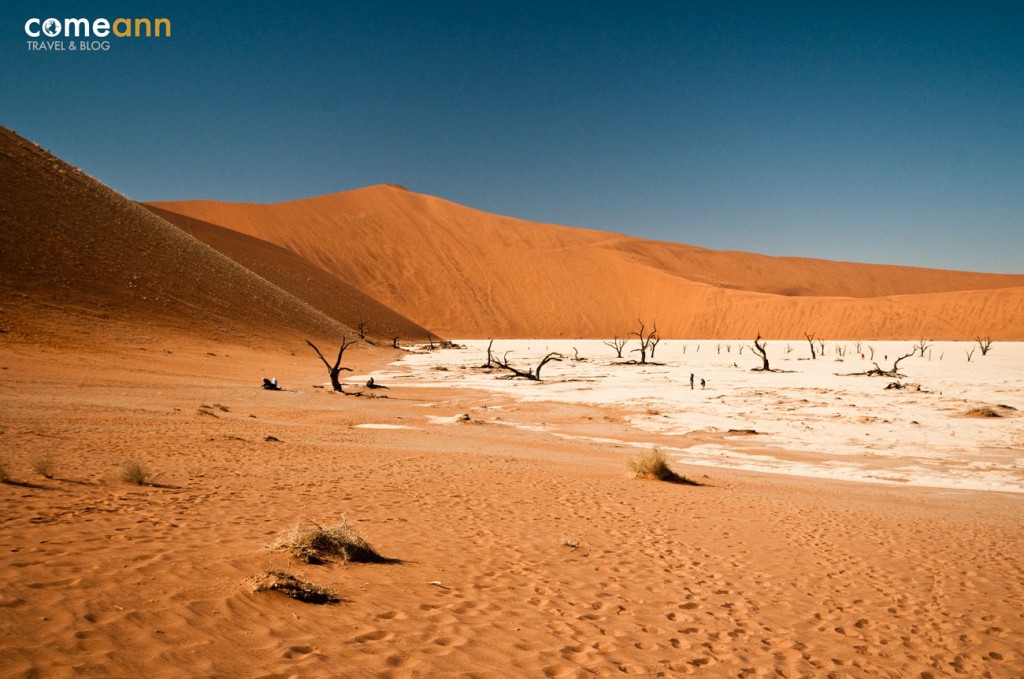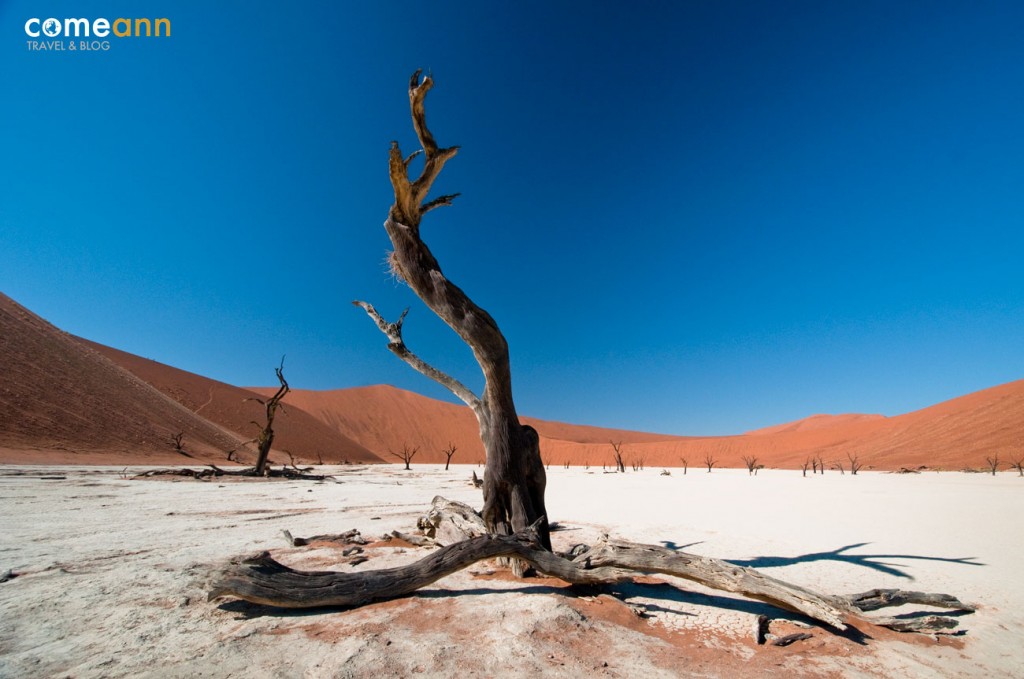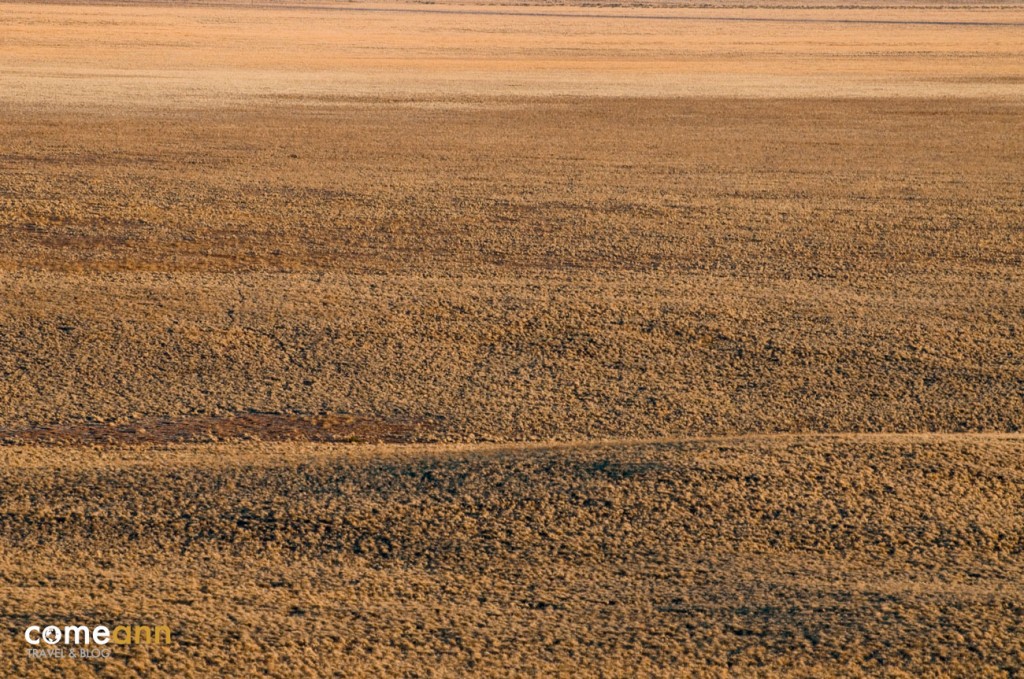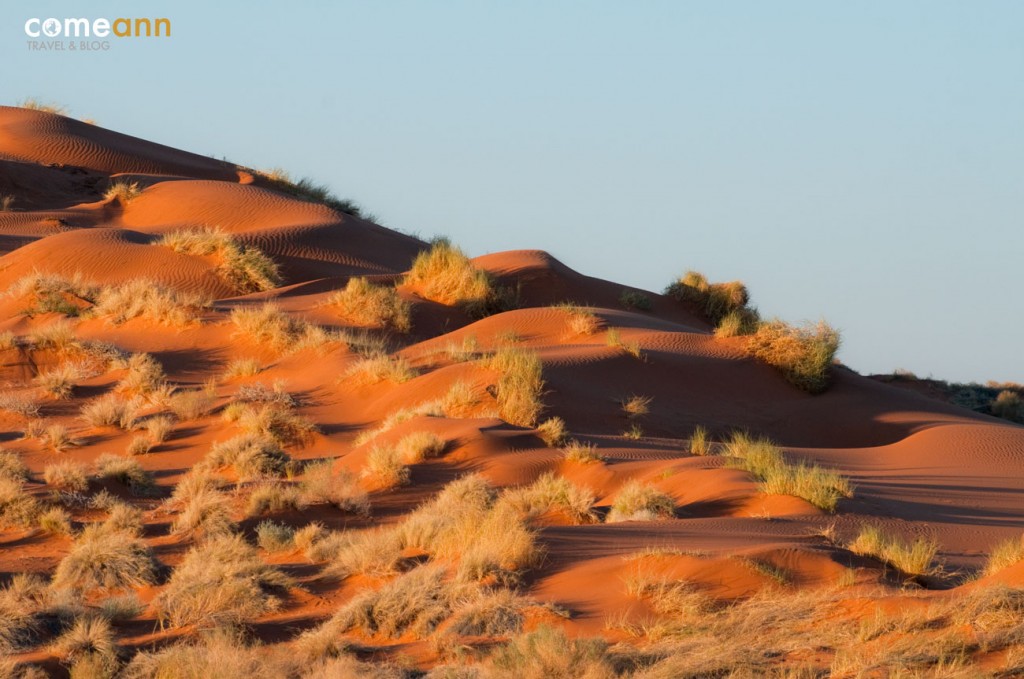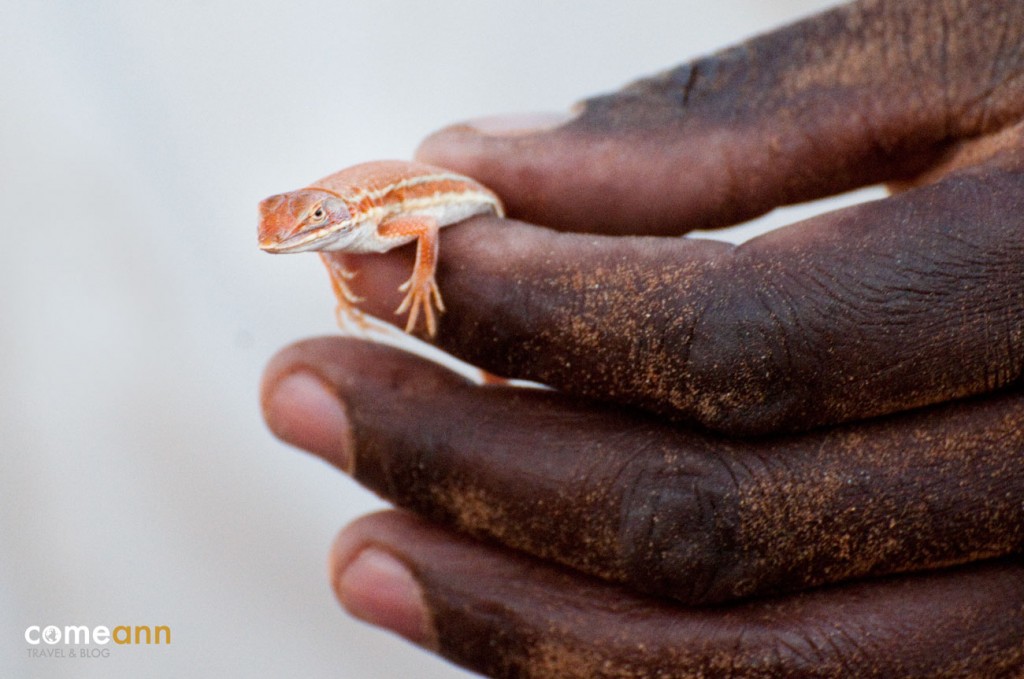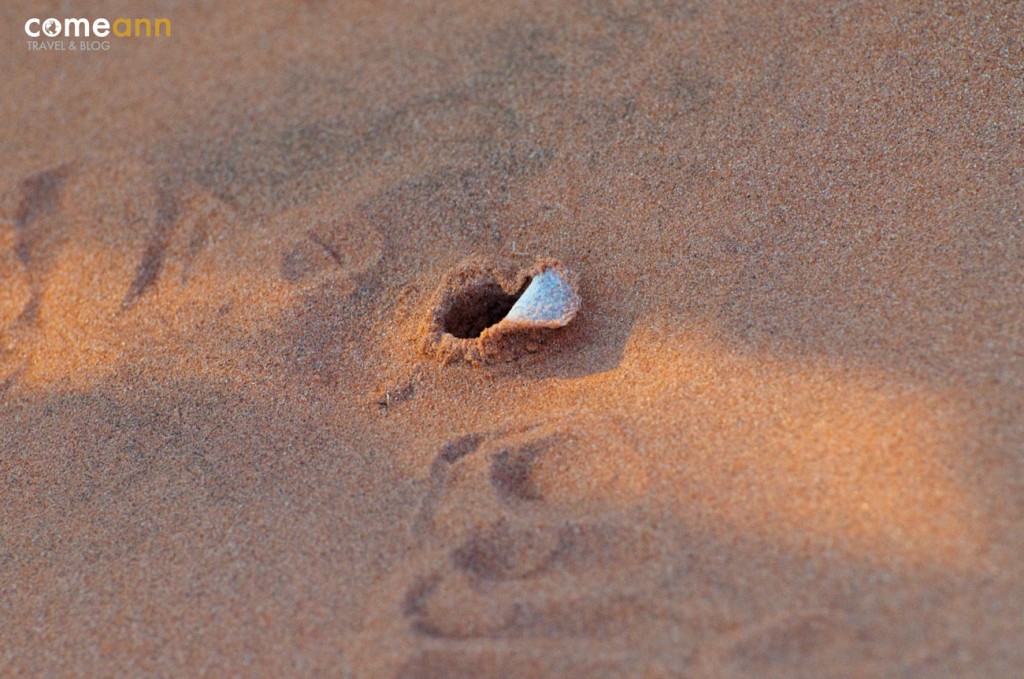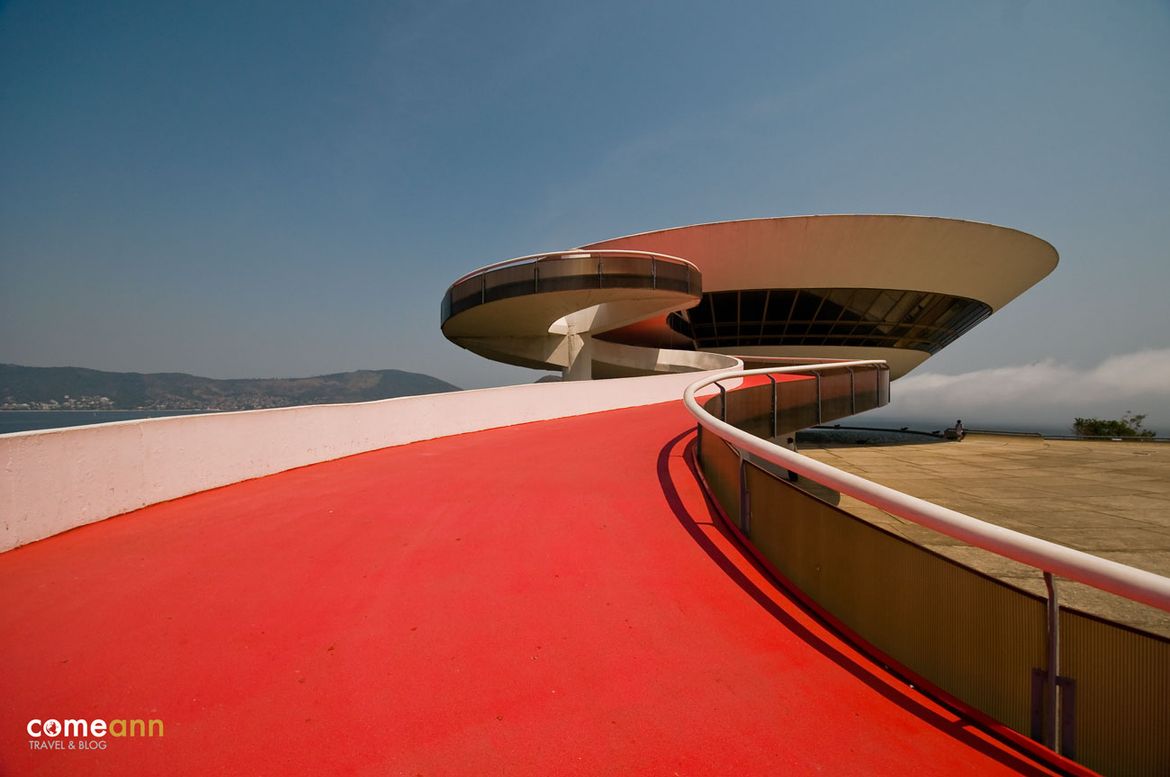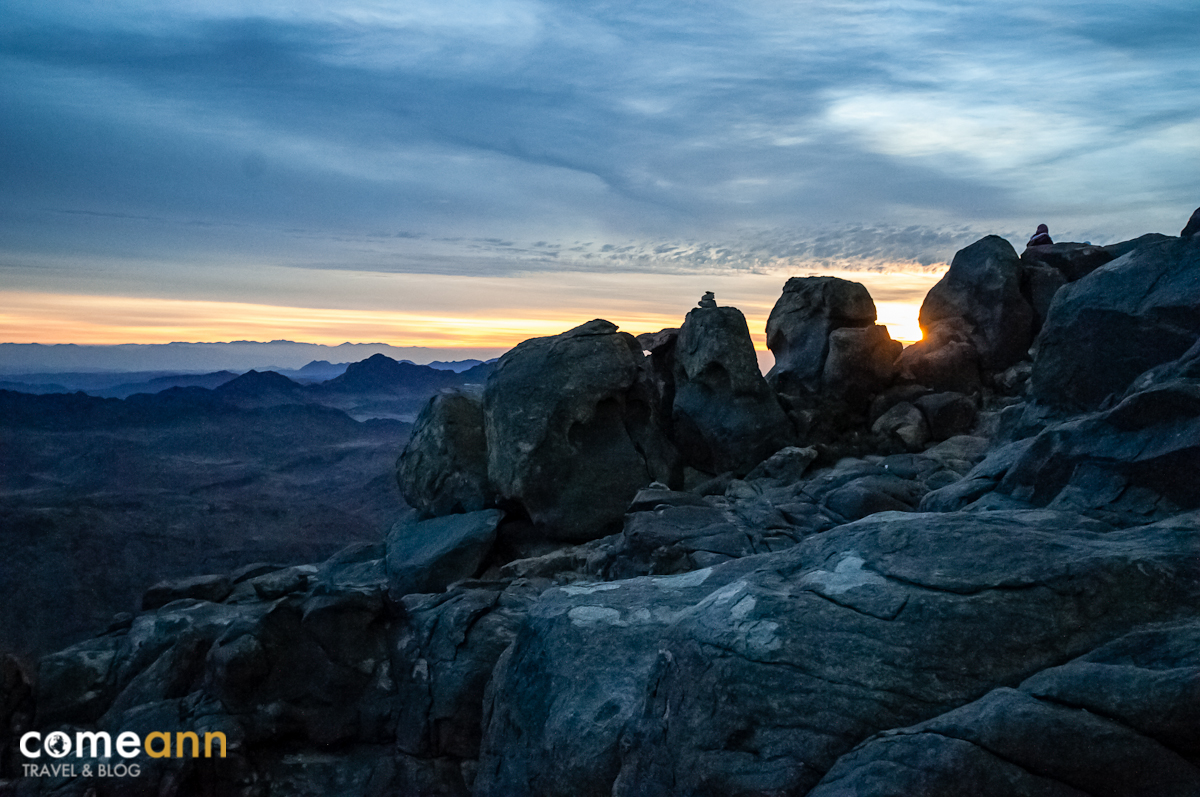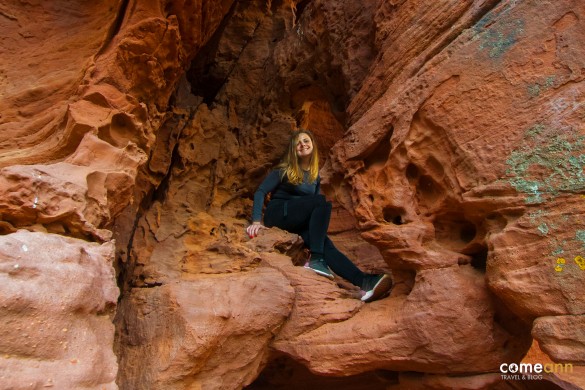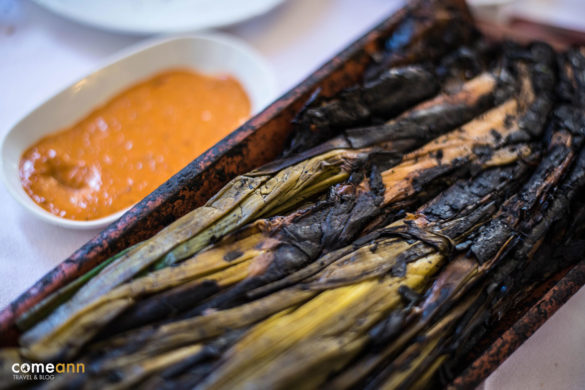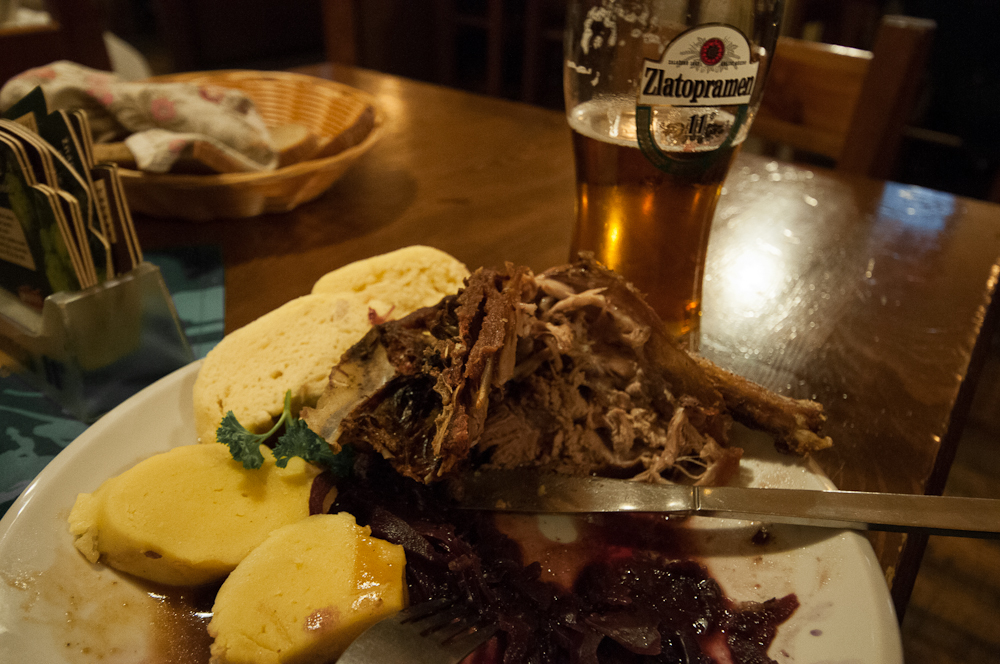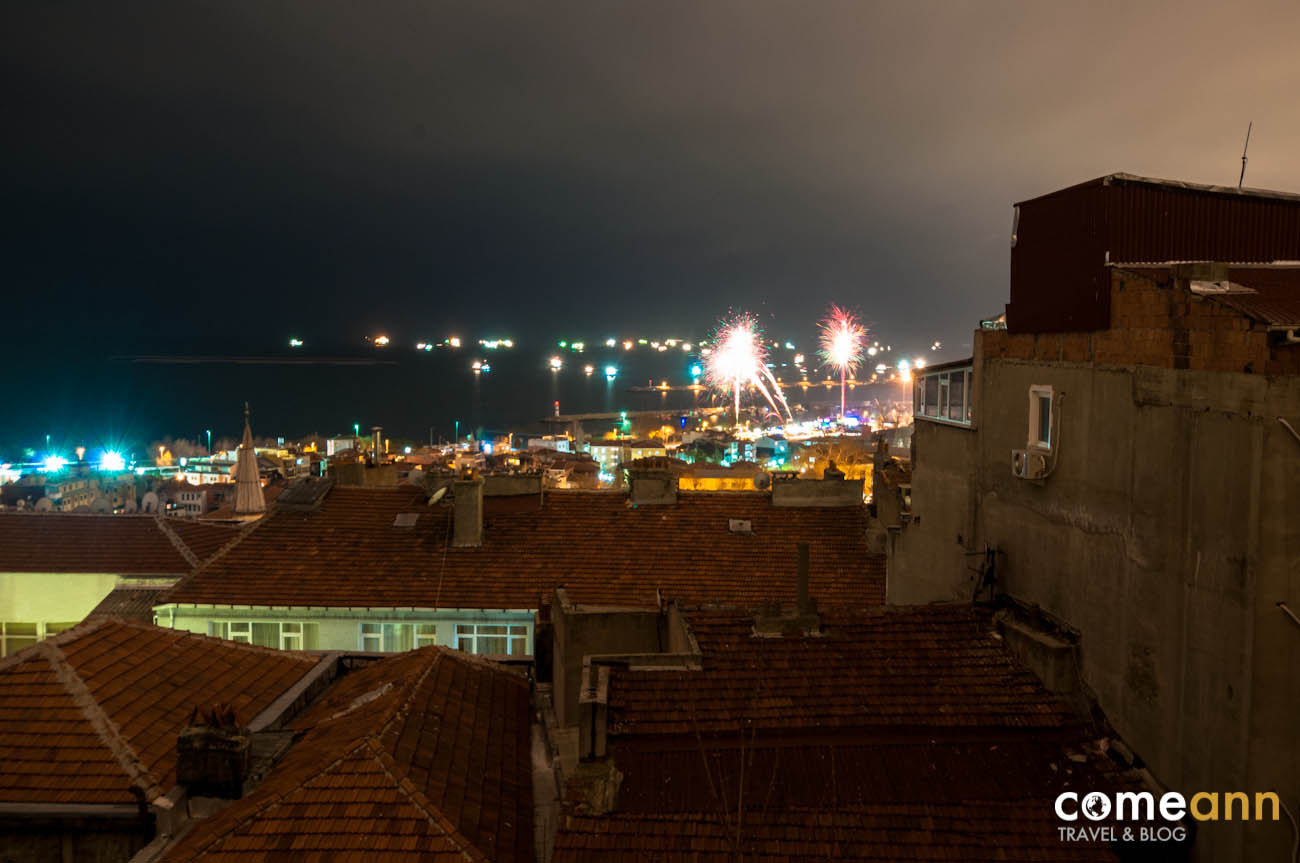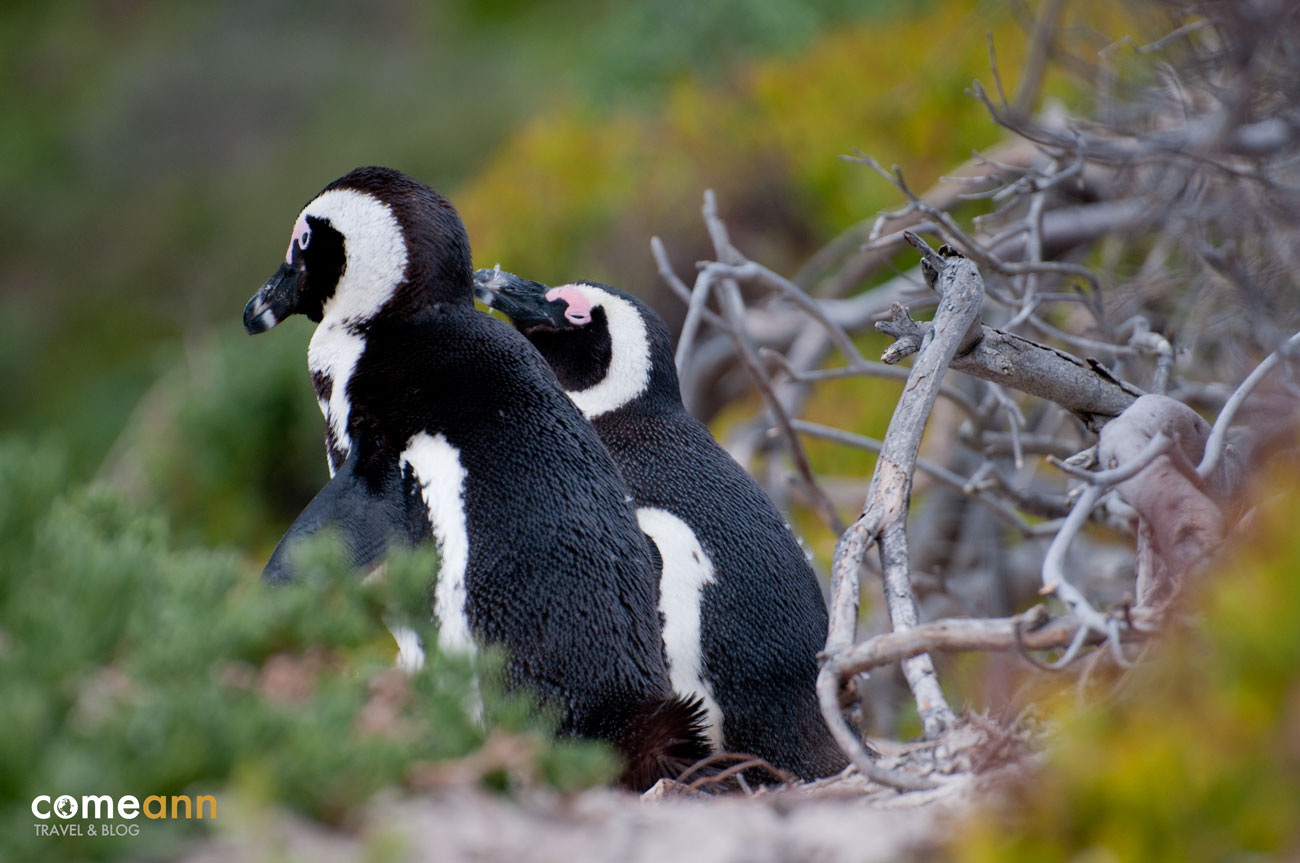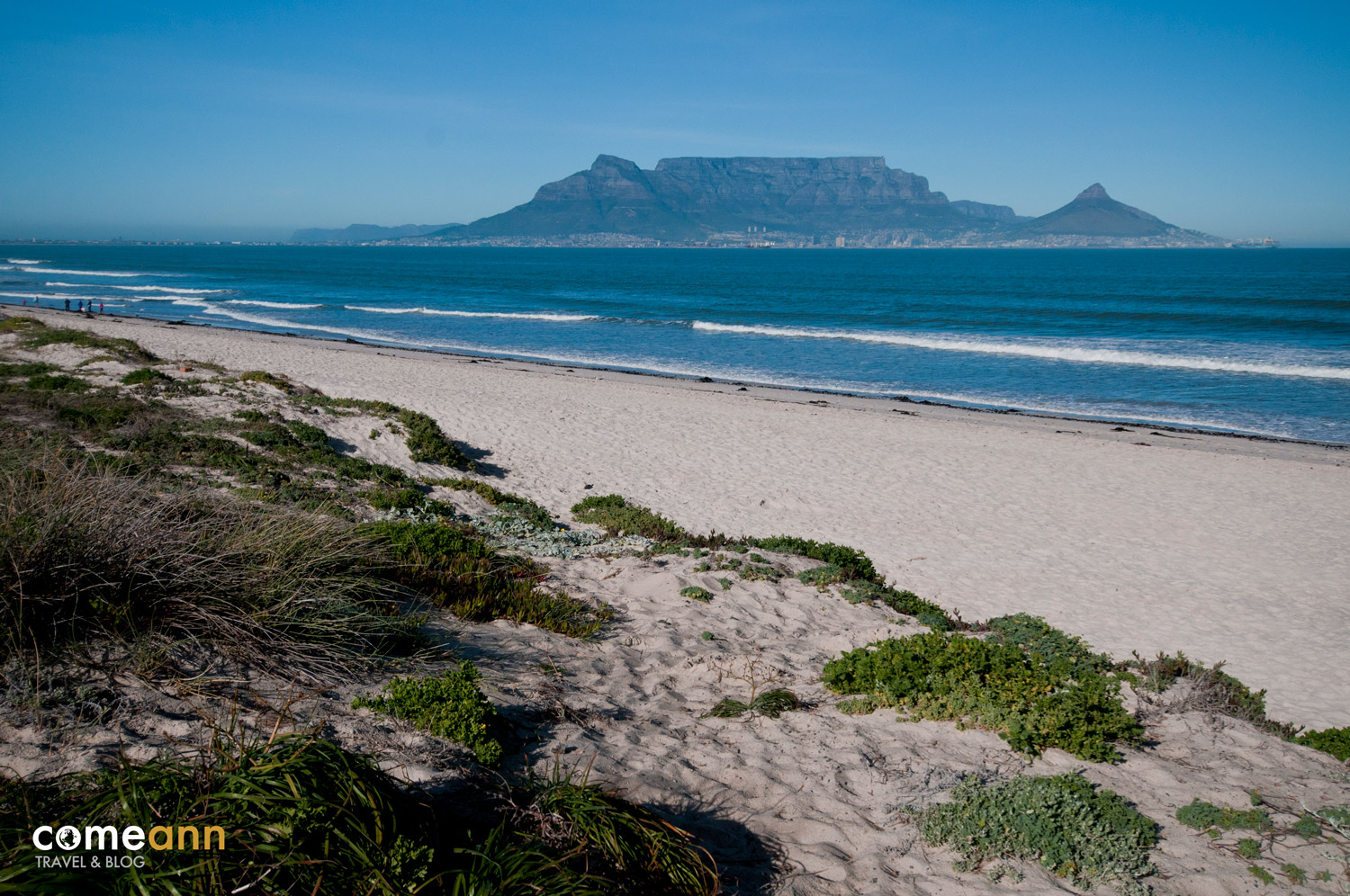Z trudem otwieram oczy… Jednak wiem już, że to będzie dzień, który zapamiętam do końca życia. Jest czwarta rano, dookoła ciemność i przeszywający chłód. Tak – zimna i rześka afrykańska noc. Z pomocą czołówki składam namiot i podekscytowana ruszam w kierunku najbardziej znanych wydm na świecie. Naprawdę długo czekałam na tę chwilę!
Wszystkim, którzy kiedykolwiek będą wybierać się do Namibii, polecam nocleg na kempingu Sesriem, gdyż goście tego pola namiotowego mają możliwość wcześniejszego wjazdu (o godzinę) do słynnych wydm w Sossusvlei – jeszcze przed całym tłumem turystów, którego należy się tu spodziewać o każdej porze roku. Wydmy w Parku Narodowym Namib-Naukluft są najczęściej odwiedzanym miejscem w Namibii i celem numer jeden wszystkich wycieczek. Zresztą nie bez przyczyny.
Już podczas drogi wiodącej do najsłynniejszej Wydmy nr 45 można obserwować wyłaniające się na horyzoncie piaskowe góry. A piasek jest naprawdę niesamowity: czerwony, pomarańczowy, purpurowy, a czasem wręcz niemal fioletowy. Tym bardziej warto zarwać noc i zacząć mozolną, piaskową wspinaczkę przed wschodem słońca, kiedy kolory są jeszcze piękniejsze i bardziej wyraziste. Słońce otula wydmy porannymi promieniami, tworząc surrealistyczne widowisko na granicy światła i cienia. Krajobraz jest wprost nieziemski!
Park Namib-Naukluft zajmuje powierzchnię aż 50 000 km². Ten ogromny obszar jest jednym z najbardziej suchych terenów na świecie. Roczne opady wynoszą zaledwie 10-14 mm, a z reguły występują tylko raz na kilka lat i tylko przez kilka dni. W tym miejscu warto też wspomnieć o pochodzeniu nazwy Namibia. „Namib” w języku nama oznacza „olbrzymi”, a w innym tłumaczeniu „miejsce, gdzie nic nie ma”. A jednak jest! Okazuje się, że nawet tak nieprzyjazne środowisko stanowi dom dla wielu gatunków pająków, jaszczurek, węży i chrząszczy, które skrywają się pod piaskiem. Dlatego właśnie nie należy chodzić po wydmach w odkrytych butach…
Zakładam specjalny, foliowy rękaw na aparat fotograficzny i zaczynam się wdrapywać na Wydmę nr 45. Jest naprawdę ciężko. Zapadam się po kostki w sypkim piasku, który wsypuje się do butów i jeszcze bardziej utrudnia wspinaczkę. Oddech staje się coraz szybszy, a widoki coraz piękniejsze. Jeszcze tylko kilka kroków i jestem na grzbiecie najczęściej fotografowanej wydmy na świecie! Mimo że usypana z piasku góra nie jest specjalnie duża, moja radość jest ogromna. Cieszę się jak dziecko! Mam ochotę skakać, a w dłoniach czuć przesypujący się i powoli nagrzewający od słońca piasek.
A trzeba zaznaczyć, że rozgrzewa się niemal do czerwoności. W ciągu dnia temperatura piasku może osiągnąć ponad 80ºC! Kolejną ciekawostką jest występująca tutaj bardzo duża ilość związków żelaza – wystarczy zbliżyć magnes do piasku, by zaobserwować przyciągnięte drobinki żelaza. Bardzo istotnym elementem wpływającym na kolor wydm jest ochra, czyli naturalna glinka pigmentowa, która pozwala turystom zachwycać się feerią barw zmieniającą się pod wpływem oświetlenia i uczestniczyć w tym niezwykłym widowisku!
Wydmy są naprawdę ogromne i wysokie, ale czy naprawdę najwyższe na świecie? Otóż nie! Wiele źródeł wprowadza wszystkich w błąd – namibijskie wydmy nie są nawet najwyższe w Afryce. Wysokość wydmy Big Daddy (mierząc od podstawy) waha się od 300 do 400 m, w zależności od pory roku i wiejących wiatrów. Powszechnie podawana wysokość to 383 m, co daje 6. miejsce w rankingu najwyższych wydm świata.
Najwyższe wydmy świata:
- Duna Federico Kirbus w Argentynie – 1230 m od podstawy.
- Cerro Blanco w Peru – 1176 m.
- Badain Jaran Dunes w Chinach – 500 m.
- Rig-e Yalan Dune w Iranie – 470 m.
- Rejon wysokich wydm na Saharze w Algierii – 465 m.
- Big Daddy/Dune 7 w Namibii – 383 m.
Dla mnie to zupełnie nieistotne, czy wydmy są najwyższe, czy nie. Są przepiękne i na pewno najbardziej popularne, a samych Namibijczyków tak bardzo rozpiera duma, że minister turystyki uznaje Wydmę nr 7, zwaną Big Daddy, za najwyższą na świecie i kropka. 🙂
Wydmy inspirują różnych twórców, zarówno fotografików, jak i reżyserów. Nie trudno się temu dziwić – plenery są naprawdę wspaniałe. To właśnie tutaj kręcono sceny do Lotu Feniksa Johna Moore’a, Bez granic Martina Campbella, czy The Trail Erica Valli.
Nie mogę się oprzeć pokusie i zbiegam ze zbocza Wydmy nr 45 najszybciej, jak mogę. Bezcenna chwila i frajda do kwadratu!
Gdy jestem już na dole, wsiadam do samochodu 4×4 – bo tylko taki jest w stanie pokonać piaszczyste podłoże – i udaję się do „Martwego Bagna”. Trochę powiało grozą, ale tak właśnie brzmi tłumaczenie bardzo znanego i charakterystycznego miejsca w Sossusvlei, gdzie zrobiono miliardy zdjęć i organizowano słynne modowe sesje.
Dead Vlei to obszar między wydmami, gdzie z jasnej, popękanej ziemi wyrastają czarne kikuty suchych akacji, tworząc niezwykły krajobraz, wyglądający niczym z innej planety. Około 1000 lat temu rzeka Tsauchab wylała się na te tereny, tworząc podmokły teren, na którym wyrosły drzewa. Jednak klimat się zmienił, a wydmy całkiem odcięły dopływ wody do Dead Vlei. Z czasem drzewa uschły, a ich spalone słońcem pnie i konary zrobiły się czarne. Ogromne wrażenie robią nie tylko ciemne kikuty, których korzenie sięgają ponad 30 m w głąb ziemi, ale także spękana ziemia, tworząca czarną pajęczynę na jasnej glinie. Dla mnie to fotograficzny raj na ziemi i jedno z piękniejszych miejsc, jakie kiedykolwiek widziałam!
Po bajkowym dniu w otoczeniu nieziemskich krajobrazów pora na nocleg na środku pustyni i wycieczkę po okolicy o zachodzie słońca. Przewodnik opowiada, jak przetrwać w tych ekstremalnych warunkach oraz jakie zagadki kryje w sobie fauna i flora okolic. Obserwuję sprytne schronienie pająka wydrążone w piasku, zwinną jaszczurkę złapaną przez przewodnika oraz sympatyczne górskie zebry, wesoło skaczące po okolicznych zboczach.
Słońce zachodzi, zalewając wszystko czerwienią i szybko zapada mrok. A ja mam nieodparte wrażenie, że tak właśnie minął jeden z najlepszych dni w moim życiu! Mam też kawałek Namibii dla mojej babci – piasek z Wydmy nr 45 zamknięty w małym pudełeczku. Dla takich dni warto żyć i warto wiele poświęcić. Po raz kolejny dziękuję, Afryko!
•••
I hardly manage to open my eyes…. However I know already it’s gonna be a day I will remember till the end of my life. It’s 4 a.m., darkness and piercing cold around. Yes – cool and brisk African night. With the help of the headlamp I fold my tent and, excited, I set off in the direction of the most famous dunes in the world. Indeed, I’ve been waiting a long time for this moment!
To everybody ever willing to visit Namibia I recommend the Sesriem camping because its guests have the possibility of setting off an hour earlier to the famous dunes in Sossusvlei, still before crowds of tourists that you should expect there any time in the year. Dunes of the Namib-Naukluft National Park are the top-visited place in Namibia and No 1 goal of all the trips. Not without the reason, anyway.
Already on your way to the most famous Dune No 45 you can observe sand mountains emerging on the horizon. The sand is really amazing: red, orange, purple, sometimes even violet. The more worthwhile it is to get up very early and begin your strenuous sand climbing before sunrise when the colors are even more beautiful and vivid. The morning sun wraps the dunes with its rays creating a surrealistic spectacle in between of light and shadow. The landscape is simply unearthly!
The Namib-Naukluft Park covers an area of as much as 50 000 km2. This enormous space is one of the most dry terrains in the world. The annual rainfall is only 10-14 mm, usually it rains once in a few years and only for a few days. In this place I should also mention the origin of the name “Namibia”. “Namib” in Nama language means “enormous” or, according to another translation, “a place where there’s nothing”. And yet it is! It turns out that even such a hostile environment is home to many species of spiders, lizards, snakes and beetles hiding in the sand. That’s why you should never walk on the dunes in open shoes…
I put a special foil sleeve on my camera and begin to climb up the Dune No 45. It’s really hard. I fall to my ankles in the sand that keeps pouring into my shoes and makes the climbing even more difficult. My breath accelerates, though the views are more and more beautiful. Only a few more steps and I am on the top of the top-photographed dune in the world! Even though the sand mountain is not that big, my joy is great. I am happy as a child! I feel like jumping, feeling in my hands the sand, slowly warming up in the rays of the sun.
And it should be noted that it can turn red hot. During the day the temperature of the sand can reach over 800C! Another titbit is the great amount of iron compounds occurring in this area – if you bring a magnet close to the sand you will observe the attracted particles of iron. A very important element influencing the dunes’ color is ochre, that is a natural clay pigment that leaves the tourists overwhelmed with the blaze of colors changing under the influence of lighting and lets them participate in this unusual spectacle!
1. Federico Kirbus dune in Argentina – 1230 m from the ground.
2. Cerro Blanco in Peru – 1176 m.
3. Badain Jaran Dunes in China – 500 m.
4. Rig-e Yalan Dune in Iran – 470 m.
5. The region of high dunes on Sahara in Algeria – 465 m.
6. Big Daddy / Dune 7 in Namibia – 383 m.
I personally find it completely unimportant whether the dunes are the highest or not. They are absolutely beautiful and certainly the most popular and the Namibians themselves are very proud that the Minister of Tourism obstinately considers Dune 7 the highest in the world.
Dunes are a source of inspiration for many artists, both photographers and film directors. It’s not very surprising – the scenes are spectacular. It’s here where the “Flight of the Phoenix” by John Moore was shot, as well as Martin Campbell’s “Beyond Borders” and Eric Valli’s “The Trail”.
I can’t resist the temptation and I run down the Dune No 45 as fast as I can. The priceless moment and incredible fun!
When I am already down I enter a four-by-four (as only such a vehicle is capable of driving on the sandy terrains) and set off to the “Dead Swamp”. Sounds a bit spooky but this is exactly the translation of a well-known and characteristic place in Sossusvlei where billions of photos where taken and famous fashion sessions were organized too.
Dead Vlei is an area in between of the dunes where from the bright cracked ground grow stumps of dry acacias creating an extraordinary landscape as from another planet. Some 1000 years ago the Tsauchab River flooded these terrains forming a wetland on which trees started to grow. Then the climate changed and the dunes cut off the water supply completely. Eventually the trees withered and the sun-burnt tree trunks and branches turned black. Truly impressive are not only the dark stumps, rooting over 30 m in the ground, but also the cracked ground making a dark cobweb in the bright clay. To me it’s a photographic paradise and one of the most beautiful places I have ever seen!
After a fabulous day in otherworldly landscapes it’s time to overnight in the middle of the desert and a tour of the area at sunset. The guide tells us how to survive in these extreme conditions and about the mysteries hidden in the flora and fauna of the surrounding area. I observe a smart shelter of a spider hollowed in the sand, an agile lizard caught by our guide and nice mountain zebras skipping merrily on the surrounding slopes.
The sun goes down pouring red color all around and soon falls the darkness. And I have an irresistible impression that one of the best days in my life has just passed! I keep a piece of Namibia for my grandma – sand from Dune No 45 closed in a tiny box. Such days are worth living and even worth many sacrifices. Thank you again, Africa!

